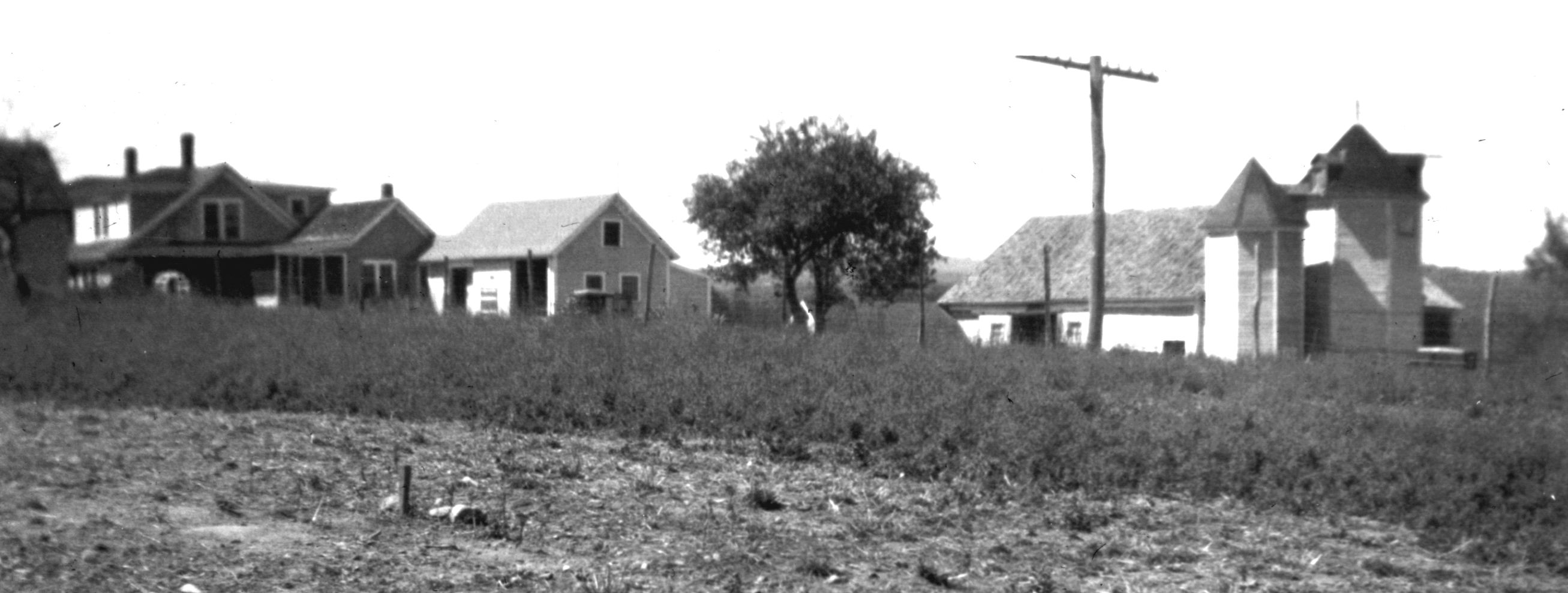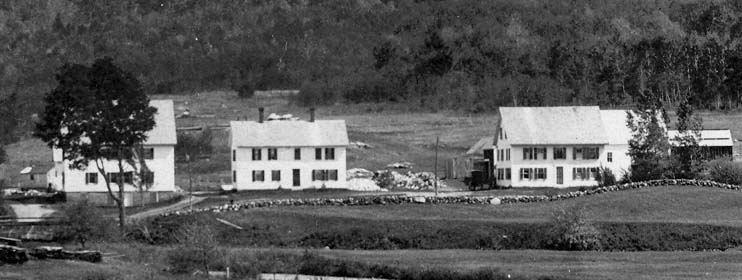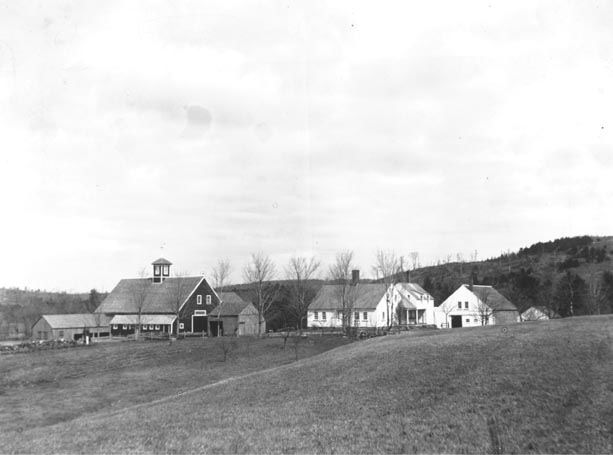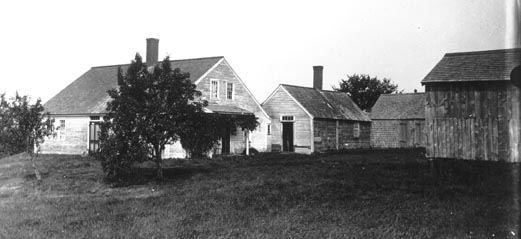HISTORY OF BLACK HALL ROAD & GOBOROUGH ROAD, EPSOM, N.H.
Told by Benjamin Marden Towle and written by Hattie Dudley.
Revised by Carleton Towle Rand in nineteen forty-five.
Original October 1936.
Black Hall Road, called in some old deeds Road to Allenstown.
Mr. Henry Sanborn is responsible for the statement that charcoal was burned on this road and hauled to market by the citizens who were called `black haulers'. Hence the road was called Black Hall (Haul) Road.
The Free will Baptist Parsonage stands at the junction of the turnpike and Black Hall Road on the west side of Black Hall Road. Present Minister Ralph E. Osborne.
The Prescott Bridge Tradition says that the bridge was so named because a man named Prescott drowned himself in
the Little Suncook River, in the meadow below the bridge. It was formerly a rattle-trap wooden bridge, quite likely to be damaged by spring freshets annually and repaired by the efforts of citizens. (shown right)
House owned by the heirs of Nathan Goss, left side of the road as one goes toward Short Falls, was built by William Goss.
Silk Mill This house and the next occupied by Robert Zinn as a dwelling were moved from the other side of the river where they formed one house known as the "Long House" on the Dickey place. This was on the present Route 28. It stood beyond the house built by Freeman Marden and was on the same side. PHOTO - below the Nathan Goss house on the left, then the two houses formerly the "Long House".
On the west side, practically opposite the Zinn plant, are three houses owned by Blanche Lane, Henry Stevens and Ernest R. Marden. These three houses were built by Charles Sumner Hall. (shown in insert photo on the left)
On the east side next comes the house owned by the heirs of William McKenzie. This was owned and occupied by James M. Clark in my childhood. Jim Clark was somewhat of a character, rather famous for his dirt and shiftlessness. Always went barefoot and seldom washed his feet. He lost a part of his hand in a planer at William Tripp's mill and delighted in showing the stump to everyone. Said machinery was a "cuss to the country." The house was built or remodeled by Robinson, think it was Black Smith shop, moved there and fixed up and that my father and James Burnham did the work. Robinson moved to Pembroke.
The house (photo right) occupied by William Burnham was formerly occupied and owned by "Squire" Ham. My father married Eliza Ham for his first wife and lived there with the Ham's. Deeds indicate that Squire Ham (William) first conveyed half the property to him and later the rest. My father lived there before moving up the hill to the Towle place. I think my father must have sold the place to James Burnham who lived and died there.
House of Benjamin Marden Towle (left photo). I built this house fifty years ago. Construction was begun in the fall of 1886 and the house was finished in the winter and we moved into it as early as February. The land was bought from James Burnham, a corner of his field.
On the hill east of Black Hall Road were three farms, the Wallace place, afterwards the Clark place, was occupied by Abram Wallace, who is buried in the old cemetery in the field. My father bought the place from the Clarks and sold the house, which was moved to Gossville.
My grandfather Benjamin Marden Towle built the Towle house (right photo), now owned by the heirs of Herbert Colby. The original Towle house was in the field east of the present house, on the side of the field toward land now owned by Eugene Philbrick. Only the cellar hole and the well remain. Simeon Towle and his wife Elizabeth (Marden) Towle came here from Rye. He was my great-grandfather. His parents, Jonathan Towle and Elizabeth (Jenness) Towle died there.
The farm now owned by Eugene Philbrick was owned by Solomon Marden, brother of Elizabeth (Marden) Towle. Later is was the Brown farm. A family named Urann lived there. In my childhood, Daniel Philbrick owned and occupied it. Charles Leighton and Jane (Bickford) Leighton, his wife, also lived there.
Charles Leighton sold the place to James Eugene Philbrick.
The Cape Cod cottage on Black Hall Road next to Benjamin Towle's building, was built in 1938 by Mr. And Mrs. Clifford Osborne. The land was deeded to them by Mr. Towle, Mrs. Dorothy (Towle Rand) being his granddaughter.
The house now occupied by Karl Fowler Rand was bought by Simeon Towle, brother to Benjamin Marden Towle, my grandfather, from a man named Dyer. Simeon Towle and Hannah (Yeaton) Towle raised a large family there, and Charles William Towle and Emeline Towle, son and daughter of Simeon and Hannah, lived there after them. Charles married after his sister's death, later becoming despondent over his financial affairs, he committed suicide by hanging in the barn.

The heir's rights were sold at auction, subject to the widow's dower rights and I bought them. Later I bought out the widow. The house was originally Cape Cod cottage type, and Charles built a two-story ell. Back of the front hall was a closet with a door which fitted miserably into the wooden partition. The upper part of the main house was unfinished and was the loom room.
On the east side of Black Hall Road stands the house occupied by James Osborne. This house was built by my grandfather Benjamin Marden Towle for his sister Perna or Parna Towle. She deeded it back to him.
Benjamin Towle, my father, sold the place to Daniel Ayers, it went into possession of Warren Yeaton, probably by mortgage. Addison Davis once lived there, also a family named Pinney. Mrs. James Fisk bought it of the Yeaton heirs and gave it to Kidder Fisk who lived there for a while and sold it to Rudolf Zinn. Zinn remodeled the house and sold it to Osborne.
The Cape Cod cottage on Black Hall Road opposite the Osborne's was built by Paul Brusquini. The land was deeded by the late Benjamin M. Towle.
The house formerly used as the Epsom Poor House stands on the west side of the road. It is now owned by Minot Yeaton and has of late years been rented. As far back as I can remember James Yeaton lived in this house and his first wife died there. James Yeaton sold the farm to his brother Daniel, father of Minot. Both James and Daniel were sons of "Uncle" Jack Yeaton. (house shown left)
It is said that this house was built by a Towle and James B. Towle was buried in a family graveyard next to the small yard where the town poor were buried. (note: Joseph Towle buried in Poor Farm cemtery) The place was known previous to its use as a poor house as the Esq. Hersey place. It was bought soon after 1848 and was used as a poor farm until about 1865 (Hist of Merrimack Co.)
Albert G. Ordway lives in the very old house where Solomon Yeaton formerly lived (shown right). After the death of Mrs. Solomon Yeaton, the place was sold to Ordway. This is probably a very early Yeaton homestead.
On the same side (East) is a rather more recent house built by Israel Garfield and now occupied by Wilfred Osborne. Israel sold the house to a family by the name of Tolman which contained at least six children. Tolman lived there for a while then sold the house to James B. Osborne. Wilfred Osborne, son of James Osborne, lives there now.
On the west side next comes the Ben Bickford house. I can remember four generations there, Old Ben, Young Ben, Joe and Joe's son who was born there. I have heard that this was an old tavern.
On the west side, up a lane, is the house occupied by Fred Yeaton. This is the "Uncle Jack" Yeaton place where he lived in very earliest days and where his son Will lived. Fred is Uncle Jack's grandson.
Just beyond the Ben Bickford house is a cellar hole where "Bill Brooks" lived. I remember going there with father when a child died. It was taken down and moved. The ell stands at Gossville. It was moved out there and Billy Bennett lived in it. This was probably a Yeaton house.
On the West side of Black Hall Road between the Ben Bickford place and the Jim C. Yeaton place, was the Hopely Yeaton place, In my early days Samuel Tom Bickford lived there. While the Rail Road was being built, horses used on the work were kept in the barn of this place and the barn took fire and was burned with all the horses.
This house was sold and torn down. William Goss bought it intending to use the timbers for a house nearer Gossville, but found it so poor he did not use it.
On the west side next comes the house of the late Samuel Yeaton. This was built by Jim C. Yeaton. He lived there and was followed by his son Samuel. The place is now occupied by Sam's widow and his sister Lizzie. (left the James C. Yeaton house with he and his family, including wife Hannah Drake Towle Yeaton)
The house opposite was the old place. It was unoccupied and deserted for many years, until repaired and renovated. Maurice Yeaton, son of Samuel, lives there. On the east side a little to the north of the house stood the old cider mill where much cider was made.
Next on the East side of the road is a new house built by Winthrop Fife, a World War II veteran. This house is built in a Spurlin pasture

.The "Jim Brown" house (above) is on the left or east side of the road. It was sold to John Spurlin. Later it came into the hands of an Italian named Santa Paula, who now lives there. The land now used as a golf course was part of the Jim Brown farm.
An old house formerly stood beyond the Jim Brown house, which was called the Spurlin house. This has been unoccupied and abandoned ever since I can remember.
The house now occupied by Leonard Batchelder was the John Spurlin house, probably built by him. This is on the east side of the road.
The Stewart house is now occupied by Mrs.George Batchelder who was Nettie Stewart and was later sold by the heirs to Langdon I. Garrison.
Short Falls used to be called Jenness Corner. A large old-fashioned house stood on the west side at the corner very near the present store occupied by Oliver Lombard. Jim Tennant bought this old house and converted it into a store. Later he built the present store building. (both buildings shown at right)
Walter Tripp's house was moved from the Fowler district and put up in the same shape as originally.
GOBOROUGH (Goboro) ROAD
An old deed in my possession which seems to be for the triangular piece of land in the fork of the road where Goborough Road separates from the turnpike, speaks of this road as the Gilmanton Road. I have always heard it called Goborough Road.
The house in the fork of the road now occupied by a Mr. Kyle and Mrs. Chase was the home of Andrew Silver. The house was moved there (I do not know from where) and put up by William Goss for his son John who started the store which is now operated by Silver and Young.
The building was formerly a carriage shop or wheelwrights. Jim McGuire worked there. It was made into a store and after the upper part was finished off for the Grand Army Hall (Gossville store, left)
The large two family house opposite was originally the Clark house on the farm bought by my father. William Goss
bought the Clark house and moved it to Gossville. It was first used as a carriage and paint shop. Later it was made into a dwelling house. Jonathan Marden once owned it and built on the ell. (right) The blacksmith has usually lived there. The blacksmith shop formerly stood near where the Public Library now stands. It was moved to its present position by William Goss. (below Moses Burnham and the blacksmith shop)
The Water Tank House was built by the Rail Road and housed large quantities of wood for running the train. Wood was used in the engine. The Marston house just beyond was bought by the Rail Road. Goborough Road then ran near the present railroad track. The Rail Road Company built the carriage road on the backside of the Marston house.
The tracks were in front and the Marston house was used as a station before the present station was built.
Towards Chichester from the old Clark house Billy Bennett used to live (right) – Warren Steven’s now lives there. Billy Bennett bought the ell of the “Red House” on Black Hall Road and moved it out to Gossville.
Next to the Billy Bennett house is the house now owned by Bert Young. This house was the Goss place in the Fowler District and formerly stood opposite the house of William Fowler. William Goss moved it out to Gossville and set it up.
House owned by Mrs. Beckley, now Mrs. Rand. This was formerly the home of old Mrs. Westcott (Stephen, I believe). It was built __ and on to from an old shop. It is now owned by the heirs of Moses Burnham. Mr. Westcott was a wheelwright.
North of the Westcott house is the house where Moses Burnham lived, now occupied by his heirs. Morrill Bickford built this house for a blacksmith named Twombly, a Frenchman (Probably about ’75 or ’76).
“Billy Burnham” bought it and lived and died there, his widow went to live with her son Fred in Penacook. Moses bought it next I think.Frank Hall, section boss for thirty years or so built the house beyond Moses Burnham’s on the same side and lived there until his death. His wife still lives there.
Just beyond this house a road turns eastward and runs up to the Sherburne place. Mrs. Lucy Sherburne, a widow, lived there and taught school in the old schoolhouse which stood where the present two room building stands. There was a path down thro’ the pasture which belonged to the Goss farm (the old Cilley place) now the hotel, through which she used to come to school. Her younger son Bert remained there and Mrs. Sherburne lived with him.
Picnics used to be held in a grove known as Mrs. Sherburne’s woods – her husband died with consumption and she brought up her three children, Lula, Horace and Bert.A still older schoolhouse is said to have stood on the east side just beyond the road to the Sherburne place. My father said he used to play in the swamp between the cemetery and the railroad and chased rabbits there.
The next house on the east side of Goborough Road is one built by Charles Palmer probably between forty and fifty years ago. (pictured is the house prior to the one built by Charles Paler, later home of George Stevens)
Next was the house where “Judge” White lived. Judge White agreed to saw wood for the ___ building the railroad as fast as they could use it. Not quite sure whether he could or not. His daughter married Sam Batchelder and the Batchelder’s lived there. Ed Batchelder later of Northwood renovated the house and kept it for some years. Now occupied by Thayer.
Just before the Judge White house was the Rufus Doe house. Rufus Doe lived there and married Orson or Orison Abbott’s daughter and raised a family there, Myra and Bert. Myra married Charles Palmer and was there a while. Later Bert lived there. It has been sold and is occupied in the summer.(right photo)
Edgar Annis has built a modern house in the field back of the Rufus Doe place.Next was the old Doe place now burned and a new house has been built by Elmer Palmer. Alexander Doe, sometimes called “Old Doe” lived here – Tom Doe lived there and later Charles after Alexander’s death.
Back of the Doe place was an orchard and the place was known as the Leighton place.
Alice Emerson lives in an old shop beyond the Doe place. This was not there in earlier days. Isaac Hall lived and died there. He was married to a sister of Arthur Marston.
The Rice Rand is next on the west side of the road. Rice Rand kept a pair of oxen until there were twenty-five years old (more or less). Charles Rand lived there and died there. I do not know what relation he was to Rice. Thomas Carr bought the place, took down the old house and built a new one. The place is now owned by Justin Stevens and son Henry.
On the west side lived William Bickford. The house is now gone. It was a Cape Cod style house. He married Polly Rand and raised children. His son Henry, married Orilla Locke and lived in Epsom.
Gorham Rand lived next on the west side. He had trouble with his wife caused, so it was said, by her perpensity to wave to the train as it went past. Aided By Lemuel Towle, she went away leaving her child Cora. Cora grew up there with her father. For many years Gorham used to set pumpkins on the gate post and label them “Lem Towle.” This place now owned by Etheridge.
In the east side was the Sanborn place. Here Henry Sanborn known as ‘Forty foot” lived. “Forty foot” was so called because he was very short. He always wore a tall silk hat. He married Shuah ___ probably Davis. He bought the Andrew Heath place and got involved and finally lost both places to Carpenter (Charles Carpenter).The Andrew Heath place on the east side of the road was occupied by Andrew Heath the elder and his son Andrew. The farm with the barn was sold to Sanborn, but the house was reserved and Andrew Heath the elder remained there. His son Andrew died rather young leaving three children I think. Will C. Heath of Manchester is his son. I am not sure whether the younger Andrew went away before his death. His family went to Manchester with his wife’s family I think. His house was sold to George Henry Rand and later burned.
The Sanborn’s finished off a room or two in the shed adjoining the barn and lived there somewhat. Later the Etheridges bought this.On the same side was an old house where “Jim” McGuire lived and the Marston’s once lived there. George Henry Rand acquired this and it burned.
On the left (west) was the home of George Henry Rand (pictured). This now belongs to an Etheridge.
The Ingalls place has been lived in by various transient people and has stood empty a good part of the time.
The old Lemuel Towle place is owned by Mrs. Mabel Bartlett. Lemuel Towle lived here succeeded by George who went to the Klondike and never returned. His family lived on at the homestead.
The house where Mark Wood lived is partly in Epsom and partly in Chichester. This house has been renovated and is occupied by a man named Gammage who married George Henry Rand’s daughter.
MOUNTAIN ROAD
The Mountain Road starts on the road to Epsom Center at the McCoy tablet and comes out by way of the Swamp Road at New Rye. The first house is that of Hollis Hall. The old house was the home of Charles Henry Hall, father of Hollis Hall.(right)
One road beyond goes to the old Andrew Hall place and the old Babb place. The Andrew Hall place is still standing.
The other road goes on by the old house once occupied by Ozum Dowst, now owned by Annie Hill.
Ozum and Martha, his wife, were a peculiar couple. They used to come out to the store waking with Ozum some twenty feet ahead. Martha was unable to speak above a whisper for many years, but finally recovered her voce. There are no more houses until you reach Anson Cass’s.
To reach the old Dearborn Moses place you go through Anson Cass’s dooryard. This was formerly Henry Cass’s.
The old Moses house is gone and a new one built where Ralph Cass lives. Ralph Cass has a poultry farm.
(Above, the Cass home)
The Tarlton place (shown left) was near the Cass place. The house has been burned and another built. Several people have lived there.
Calvin Dowst lived on the Mountain Road. Also Mary and Martha Libbey. Calvin married Mary and moved up with the Libbey’s. Martha was very masculine and has in later life very much bent from doing hard work. (shown below)



